| dc.contributor.author | Rørstadbotnen, Robin Andre | |
| dc.contributor.author | Dong, Hefeng | |
| dc.contributor.author | Landrø, Martin | |
| dc.contributor.author | Duffaut, Kenneth | |
| dc.contributor.author | Growe, Kevin | |
| dc.contributor.author | Kakhkhorov, Umedzhon | |
| dc.contributor.author | Wienecke, Susann | |
| dc.contributor.author | Jacobsen, Joacim | |
| dc.date.accessioned | 2023-07-25T08:43:11Z | |
| dc.date.available | 2023-07-25T08:43:11Z | |
| dc.date.created | 2023-06-29T09:50:45Z | |
| dc.date.issued | 2023 | |
| dc.identifier.citation | Geophysics. 2023, 88 (5), 1-16. | en_US |
| dc.identifier.issn | 0016-8033 | |
| dc.identifier.uri | https://hdl.handle.net/11250/3081222 | |
| dc.description.abstract | Quick clay avalanche is one of the most devastating landslide types worldwide. Hence, an early warning system is in demand to mitigate the fatal consequences caused by such events. To address this, distributed acoustic sensing data are collected in an area containing quick clay deposits between July 2021 and February 2022 in Rissa, Norway, while a new road is constructed on the quick clay. Road construction can induce unwanted changes to the mass balance in the clay, and previous landslides have been triggered by such changes. For this purpose, passive and active data are collected to test and compare various analysis methods. Using extracted Rayleigh wave dispersion from active sledgehammer shots, shear-wave velocity depth profiles covering the first 15 m could be estimated and compared using a linearized and a nonlinear surface wave inversion method. Furthermore, ambient noise crosscorrelation is used to obtain the dispersion from the ambient noise and associated shear-wave velocity profiles, providing two possible data collection methods for the early warning system. The obtained dispersion curves and the estimated shear-wave velocity profiles show small time-laps variation during the acquisition period (up to approximately 23 m/s), where the variation is within one standard deviation. Such a small variation suggests that the construction work and the extra load added to the quick clay do not alter the quick clay’s properties. Nevertheless, the obtained results capture the nonrepeatability effects within the acquisition period and provide reference curves for the study area at undisturbed conditions and valuable information for future comparisons to refer to potential failure scenarios. This is the first step in exploring an early warning system for quick clay landslides using fiber-optic cables. Further work will investigate the possibility of automatizing the system and improving the accuracy of the sensing system. | en_US |
| dc.language.iso | eng | en_US |
| dc.publisher | Society of Exploration Geophysicists | en_US |
| dc.rights | Navngivelse 4.0 Internasjonal | * |
| dc.rights.uri | http://creativecommons.org/licenses/by/4.0/deed.no | * |
| dc.title | Quick clay monitoring using distributed acoustic sensing: A case study from Rissa, Norway | en_US |
| dc.title.alternative | Quick clay monitoring using distributed acoustic sensing: A case study from Rissa, Norway | en_US |
| dc.type | Peer reviewed | en_US |
| dc.type | Journal article | en_US |
| dc.description.version | acceptedVersion | en_US |
| dc.source.pagenumber | 1-16 | en_US |
| dc.source.volume | 88 | en_US |
| dc.source.journal | Geophysics | en_US |
| dc.source.issue | 5 | en_US |
| dc.identifier.doi | 10.1190/GEO2022-0251.1 | |
| dc.identifier.cristin | 2159293 | |
| cristin.ispublished | true | |
| cristin.fulltext | postprint | |
| cristin.qualitycode | 2 | |

